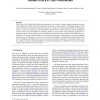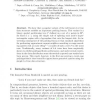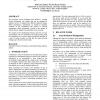126
click to vote
EGH
2010
Springer
14 years 10 months ago
2010
Springer
The k-D tree is a well-studied acceleration data structure for ray tracing. It is used to organize primitives in a scene to allow efficient execution of intersection operations be...
NIPS
2007
15 years 1 months ago
2007
We present a simple variant of the k-d tree which automatically adapts to intrinsic low dimensional structure in data.
96
Voted
ESA
2000
Springer
15 years 4 months ago
2000
Springer
We show that a popular variant of the well known k-d tree data structure satisfies an important packing lemma. This variant is a binary spatial partitioning tree T defined on a set...
120
click to vote
3DIM
2003
IEEE
15 years 4 months ago
2003
IEEE
A method is presented that uses an Approximate Nearest Neighbor method for determining correspondences within the Iterative Closest Point Algorithm. The method is based upon the k...
102
Voted
VRST
2003
ACM
15 years 5 months ago
2003
ACM
We investigate several techniques that partition a crowded virtual environment into regions that can be managed by separate servers or mapped onto different multicast groups. When...



